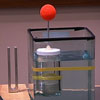-

-
Courses
Find courses by:
Collections
Cross-Disciplinary Topic Lists
- About
- Donate
- Featured Sites

 |
|
By the end of this lecture, you should:
› View/hide answer
0.0172 m; 17.2 m
› View/hide answer
\[\frac{l}{g} \sf{\mbox{has units}} \frac{[m]}{[m/{{s}^{2}}]}=\frac{[1]}{[1/{{s}^{2}}]}=[{{s}^{2}}]\]
\[\frac{m}{k} \sf{\mbox{has units}} \frac{[kg]}{[N/m]}=\frac{[kg]}{[kg\cdot m/{{s}^{2}}/m]}=[{{s}^{2}}]\]
The only further operation is a square root which gives [s].
› View/hide answer
\[\omega =\sqrt{\frac{g}{l}}\]
makes sense since we would think the higher restoring force from a higher “g” would make a pendulum go faster, while a longer pendulum is know to vibrate more slowly
\[\omega =\sqrt{\frac{k}{m}}\]
makes sense since a stiffer spring vibrates with higher frequency, while a larger mass being pushed by a spring moves ponderously.
› View/hide answer
377 rad/s
› View/hide answer
360º or equivalently, 2π radians